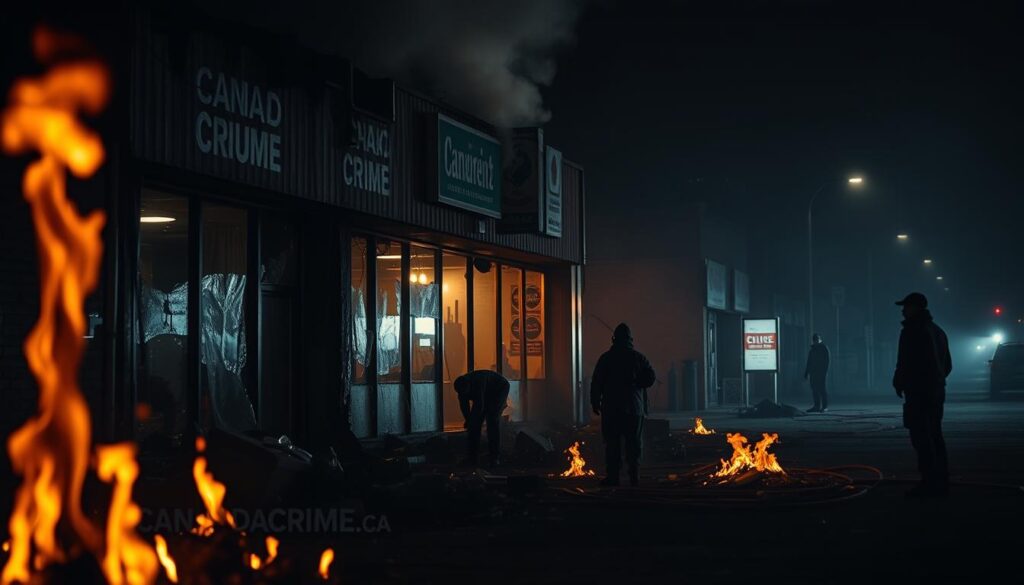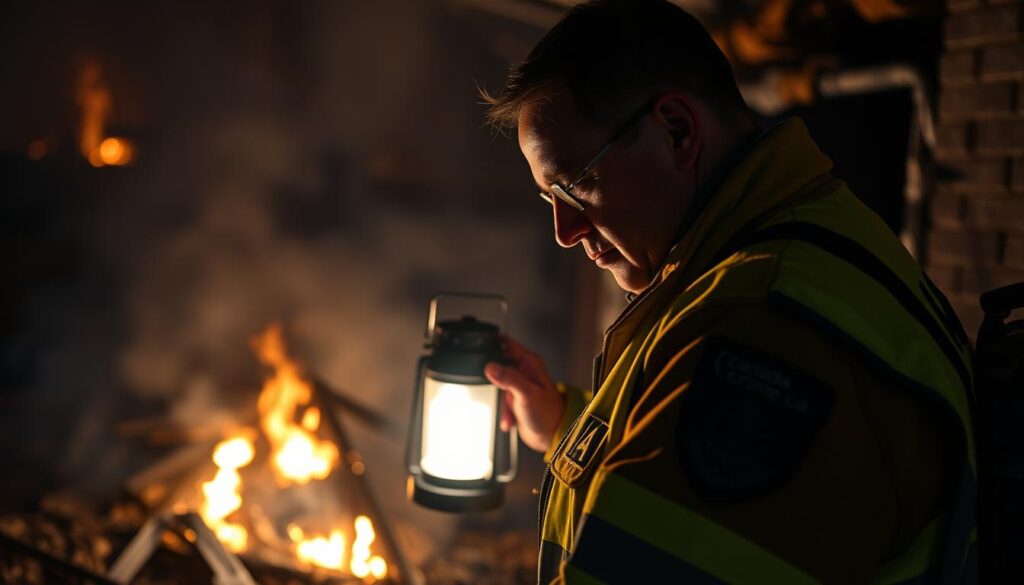Fire crimes cost Canadians over $200 million in property damage yearly. These destructive blazes often result from deliberate human actions. Intentional fire-setting is one of the most devastating offenses in our legal system.
The Criminal Code of Canada takes these acts seriously. Part XI addresses “Wilful and Forbidden Acts in Respect of Certain Property”. It outlines five distinct arson offenses, recognizing the unique dangers of fire-setting.
Fire-setting goes beyond simple property crimes. These complex offenses have various motivations and methods. Reasons range from insurance fraud to revenge, but the consequences are always severe.
Understanding legal classifications of fire-setting crimes is crucial. It shows how Canadian law protects communities. Recent high-profile cases, like suspected arson in wildfires, highlight the importance of this knowledge.
What Constitutes Arson Under Canadian Law
Canadian law defines arson as more than just setting fires. It includes various criminal acts with different levels of severity. Understanding this legal framework helps recognize and address these destructive offenses.
Arson causes millions in damages across Canada annually. The law classifies it as a willful destruction offense with serious consequences.
Legal Definition in the Criminal Code of Canada
The Criminal Code of Canada covers arson in Part XI. This section outlines five distinct arson offenses. Each offense has its own elements and penalties.
- Section 433: Arson – disregard for human life (maximum penalty: life imprisonment)
- Section 434: Arson – damage to property
- Section 434.1: Arson – own property
- Section 435.1: Arson – fraudulent purposes
- Section 436: Arson – negligence
The harshest penalty applies when arsonists know a property is occupied. It also applies when their actions harm others. This framework covers various scenarios of malicious burning.
Key Elements of Criminal Fire-Setting
To convict someone of arson, prosecutors must prove several key elements. These include intent or recklessness, and damage caused by fire or explosion.
They must also show property damage occurred. In some cases, specific motivations like fraud must be proven.
- Intent or recklessness (the mental element or mens rea)
- Causation of damage through fire or explosion (the physical element)
- Property damage (whether belonging to the accused or others)
- In some cases, specific motivations like fraud or concealing other crimes
The Criminal Code considers property ownership when applying charges. Different sections apply based on who owns the damaged property. This approach ensures appropriate charges for each case.
“The essence of arson as a criminal offense lies in the deliberate or reckless application of fire with the knowledge that damage will likely result. This distinguishes it from accidental fires where no criminal intent exists.”
Distinction Between Arson and Accidental Fires
Intent or recklessness separates criminal arson from accidental fires. Fire investigators search for evidence of deliberate action. They look for specific signs that point to arson.
- Multiple points of origin in the fire pattern
- Presence of accelerants like gasoline or other flammable liquids
- Removal of valuables before the fire occurred
- Disabled smoke detectors or fire suppression systems
Proving arson requires showing the fire was willful destruction, not an accident. This often involves complex forensic investigation techniques. Investigators must determine the fire’s origin and cause.
Authorities carefully document and analyze evidence in potential arson cases. They work to distinguish between criminal acts and accidents. This process may involve fire investigators, forensic experts, and multiple agencies.
Types of Arson Offenses in Canadian Jurisdictions
Canadian law classifies arson offenses into multiple categories. These categories are based on the target, intent, and potential harm to human life. The Criminal Code outlines specific provisions for different fire-setting acts.
The Criminal Code of Canada categorizes arson offenses under several key sections:
- Section 433 – Arson with disregard for human life
- Section 434 – Arson causing damage to property not wholly owned by the perpetrator
- Section 434.1 – Arson causing damage to own property that threatens others
- Section 435 – Arson for fraudulent purposes
- Section 436 – Arson by negligence
Residential Property Fires
Residential arson is one of the most dangerous forms of fire-setting. It directly endangers human lives. Perpetrators targeting inhabited dwellings face the most severe penalties, up to life imprisonment.
These cases often stem from domestic disputes, revenge scenarios, or pyromania. Pyromania is a condition where people enjoy setting or watching fires. Fires can spread quickly in neighborhoods, increasing potential harm.
Commercial and Industrial Targets

Arson targeting businesses often has financial motivations. These incidents typically fall under Sections 434 or 435 of the Criminal Code. Insurance fraud is a common objective in these cases.
The impact goes beyond property damage. It includes business interruption, job losses, and economic harm to communities. Investigators look for signs of planned burning and financial distress.
Vehicle Fire-Setting
Vehicle arson is often linked to insurance fraud or crime concealment. It can also be an act of vandalism or revenge. These cases usually fall under Section 434.
Vehicles create intense burning conditions that can destroy evidence. However, modern forensic techniques can often reveal accelerant patterns even after severe burning.
Wildland and Forest Fire Crimes
Wildland and forest fire crimes can destroy vast areas of natural habitat. They threaten multiple communities and require massive resources to combat. The Criminal Code treats these offenses severely when they endanger human settlements.
Recent Canadian wildfires have increased scrutiny of potential arson causes. Investigators receive special training to spot human-caused fires. They look for patterns that indicate deliberate fire-setting rather than natural causes.
The Prevalence of Arson Across Canadian Provinces
Fire crime in Canada shows troubling patterns that vary across provinces and territories. Thousands of suspected arson cases are documented annually. Property damage estimates reach hundreds of millions of dollars.
This criminal threat varies by region, population density, and socioeconomic factors. Comprehensive national data collection remains challenging for fire investigation agencies.
National Statistics and Recent Trends
Statistics Canada and provincial fire marshal offices compile arson data across the country. Recent trends show increased fire crime in urban centers, particularly in abandoned properties.
Economically disadvantaged neighborhoods have also seen a rise in arson incidents. Arsonists’ methods have become more sophisticated, especially in the use of accelerants.
This technical advancement complicates detection and evidence collection efforts. Fire investigation units face new challenges in combating these evolving techniques.

Provincial and Territorial Variations
Arson cases in Canada reflect diverse geographic and demographic realities. Ontario and Quebec’s urban centers typically report higher numbers of arson cases.
Northern territories experience higher per-capita rates despite smaller populations. British Columbia faces unique challenges with wildfire arson during severe fire seasons.
Climate change has intensified these fire seasons, causing catastrophic environmental and economic damage. Alberta and Saskatchewan have reported notable incidents involving agricultural property and rural structures.
These rural cases often involve different motivations and patterns than urban fire crime. Specialized investigation approaches are required when accelerant evidence is found.
Economic and Social Impact on Communities
Arson’s effects extend beyond immediate property destruction. Insurance costs have risen due to arson-related claims, affecting all property owners.
Communities targeted by repeated fire crime face decreased property values and business closures. Residents often experience psychological trauma from these incidents.
The economic burden includes increased emergency service costs and temporary housing needs. Long-term community revitalization challenges also arise from frequent arson attacks.
Municipal governments recognize that addressing arson requires comprehensive strategies. These approaches combine law enforcement responses with community development initiatives.
They aim to address underlying social factors contributing to fire-setting behavior. Improved detection of accelerant use in suspicious fires is also a key focus.
Motivations Behind Criminal Fire-Setting
Deliberate fires have specific motivations that help investigators understand and prevent arson crimes. By recognizing patterns, authorities can develop strategies to combat arson and protect communities. These motivations fall into four categories, each influencing how crimes are investigated and prosecuted.
Financial Gain and Insurance Fraud
Financial benefit, especially through insurance fraud, is a common driver behind arson. Section 435(1) of the Criminal Code addresses this motivation specifically. It creates a separate offense category for arson committed with fraudulent intent.
Canadian law allows prosecutors to use insurance policy beneficiary status as evidence of fraudulent intent. This provision helps build cases against individuals who burn their property for insurance payouts. Typical perpetrators include struggling business owners, property owners in declining markets, or those escaping underwater mortgages.
Revenge and Personal Disputes
Emotional conflicts often motivate arson attacks on homes, vehicles, or businesses. These fires usually target estranged partners, former employers, or business competitors. The personal nature of revenge-motivated arson often leads to reckless behavior and higher risk to human life.

This recklessness can trigger serious charges under Section 433 of the Criminal Code. It’s especially true when the fire endangers human life.
Psychological Factors and Pyromania
Psychological motivations behind fire-setting challenge both legal and mental health systems. True pyromania is a rare impulse control disorder. It’s characterized by deliberate fire-setting for psychological gratification rather than external rewards.
Pyromania accounts for only a small percentage of arson cases in Canada. Fire-setting behavior is more commonly linked to other mental health conditions or substance abuse. These cases raise questions about criminal responsibility and appropriate interventions.
Crime Concealment and Diversion
Some criminals use fire to destroy evidence or distract emergency services. Organized crime groups may use arson to intimidate witnesses or eliminate competition. These sophisticated cases often involve professional techniques and careful planning to avoid detection.
The dual criminal intent makes these cases particularly serious in the eyes of the law. They represent calculated attempts to subvert justice through destruction. Understanding these patterns helps authorities develop prevention strategies and build stronger cases against suspects.
For property owners, recognizing these motivations can inform better security measures and risk management approaches.
Arson Investigation Procedures in Canada
Canadian fire investigations blend forensic science, detective work, and agency teamwork. Investigators follow strict protocols to determine fire origins and causes. They collect evidence that can stand up in court.
These investigations need special training and careful methods. Experts must tell the difference between accidents and crimes. They use scientific approaches to solve complex fire puzzles.
Role of Provincial Fire Marshals
Provincial fire marshals lead fire investigations across Canada. These specialized officials operate under provincial legislation with broad investigative powers. They can enter buildings, secure fire scenes, and gather evidence.
Fire marshals provide crucial technical know-how for criminal cases. Their findings about fire causes often become key evidence in arson trials. They work independently but team up with local fire departments and police.

Identifying Accelerants and Fire Patterns
Analyzing fire patterns is crucial in modern arson investigation. Experts look for unusual burn marks that might show the use of flammable liquids. These patterns often differ from normal fire behavior.
Accelerant detection uses various methods. Special dogs can sniff out tiny traces of accelerants. Portable detectors provide quick field tests. Careful sampling ensures a thorough scene examination.
Investigators document unusual burn patterns including:
- V-pattern burns that indicate origin points
- Low burns suggesting liquid accelerants
- Multiple, unconnected points of origin
- Unusual fire progression inconsistent with accidental causes
Evidence Collection and Forensic Analysis
Fire’s destructive nature makes evidence collection challenging. Investigators must carefully document the scene before touching anything. This documentation is vital for later analysis and court cases.
Proper techniques are crucial for collecting and preserving lab samples. Maintaining a secure chain of custody keeps evidence safe throughout the investigation. Labs use advanced methods to identify specific accelerants, even in tiny amounts.
Coordination Between Fire Services and Law Enforcement
Good arson investigation requires smooth teamwork between agencies. Fire officials determine causes while police secure the scene and find witnesses. Complex cases may need joint task forces with diverse experts.
This approach ensures both fire investigation and criminal aspects get proper attention. It combines technical fire knowledge with police investigative skills for the best results.
| Agency | Primary Role | Investigative Tools | Legal Authority |
|---|---|---|---|
| Provincial Fire Marshal | Determine fire origin and cause | Pattern analysis, accelerant detection | Provincial Fire Safety Acts |
| Local Fire Department | First response, scene preservation | Initial documentation, witness interviews | Municipal bylaws |
| Police Services | Criminal investigation | Suspect interviews, background checks | Criminal Code of Canada |
| Forensic Laboratory | Scientific analysis | Chemical testing, microscopy | Evidence certification |
Legal Consequences for Arson Offenders
Fire crime in Canada carries severe legal consequences. The justice system treats arson seriously due to its potential dangers. These penalties show how the law addresses this form of willful destruction.
Criminal Code Penalties and Sentencing Guidelines
Canada’s Criminal Code sets specific penalties for different arson offenses. These reflect the crime’s severity and its impact on lives and property.
The most serious arson offense falls under Section 433. It addresses fires set with disregard for human life. This category carries a maximum sentence of life imprisonment.
| Criminal Code Section | Offense Type | Maximum Sentence | Key Elements |
|---|---|---|---|
| Section 433 | Disregard for human life | Life imprisonment | Fires in occupied buildings or causing bodily harm |
| Sections 434/434.1 | Property damage | 14 years | Damage to property not owned by offender |
| Section 435 | Fraudulent purposes | 10 years (indictable) | Fire set for insurance fraud or financial gain |
| Section 436 | Negligent arson | 5 years (indictable) | Fire caused by criminal negligence |
Aggravating Factors in Canadian Arson Cases
Several factors can increase the severity of sentences in arson cases. Courts consider these elements when deciding punishments for fire crime offenders.
Targeting vulnerable groups like seniors or children increases penalties. Setting fires to cultural or religious properties is also viewed seriously.
When arson causes injuries or deaths, sentences approach maximum penalties. Courts also consider sophisticated methods used to avoid detection.

High-risk conditions, like setting fires during droughts, are aggravating factors in sentencing decisions.
Notable Precedent-Setting Cases
Landmark Decisions
Canadian law includes landmark decisions that shaped arson case handling. The R. v. Tatton (2015) case established arson as a general intent offense.
This decision impacted defense strategies across Canada. Other precedents set standards for evidence in circumstantial arson cases.
Recent High-Profile Convictions
Recent arson convictions have reinforced the consequences of willful destruction by fire. Courts have imposed substantial sentences in cases endangering lives.
These cases serve as deterrents and show the justice system’s commitment to community protection. They also highlight improved forensic techniques in prosecuting arson offenders.
Protecting Your Property from Arson Attempts
Safeguarding your property against arson involves a multi-layered security approach. Strategic measures can reduce the risk of becoming a target. They also ensure you’re prepared if such an event occurs.
Security Measures for Homes and Residences
Effective home protection starts by eliminating opportunities for arsonists to operate undetected. Install motion-activated lighting around your property’s perimeter. Focus on dark corners and potential hiding spots.
Secure all entry points, including basement windows and utility entrances. Use modern security cameras with night vision capabilities. These serve as deterrents and evidence-gathering tools.
Keep your property clear of materials that could fuel fires. Store flammable items away from your home’s exterior walls. Regularly trim vegetation and remove dried leaves that could easily ignite.

Business and Commercial Property Safeguards
Commercial properties face unique arson risks requiring specialized protection strategies. Implement comprehensive security systems with fire detection and intrusion alarms. Include 24/7 video surveillance with remote monitoring capabilities.
Control access to your property, especially after business hours. Secure dumpsters and waste containers that could become ignition points. Consider installing perimeter fencing and hiring security personnel for larger facilities.
Develop thorough employee screening procedures and proper termination protocols. Disgruntled former employees might resort to arson as revenge. These practices are essential to your security strategy.
Insurance Considerations for Fire Damage
Review your insurance policy regularly to ensure it covers fire damage adequately. Coverage should include structural repairs, content replacement, and additional living expenses. These are crucial if your home becomes uninhabitable.
Document your property’s contents through photographs and detailed inventory lists. Store these records off-site or digitally in cloud storage. This ensures they survive if a fire occurs.
Insurance companies investigate suspicious fires thoroughly. Maintaining proper security measures shows you’ve taken reasonable precautions to prevent arson.
Community Watch Programs
Collective vigilance significantly enhances arson prevention efforts. Establish or join neighborhood watch groups that include arson awareness. Report suspicious activities around vacant properties to local authorities immediately.
Work with local fire departments on community education programs. These often focus on fire safety and arson prevention. Building relationships with neighbors creates an informal surveillance network.
| Property Type | Primary Security Measures | Secondary Measures | Community Involvement |
|---|---|---|---|
| Residential | Motion lighting, security cameras | Removing combustibles, secure entry points | Neighborhood watch participation |
| Commercial | Alarm systems, surveillance | Access control, security personnel | Business district associations |
| Vacant Properties | Regular inspections, secure boarding | Maintained appearance, lighting | Neighbor notification system |
| Industrial | Perimeter fencing, guard service | Chemical storage protocols, fire suppression | Industry safety networks |
Community connections prove valuable during periods of increased risk. These include seasonal celebrations involving fireworks or times of social unrest. Neighbors can identify and report unusual behavior before fires are set.
Reporting Suspicious Fire-Setting Activities
Observant citizens play a crucial role in fighting arson in Canada. Your quick reporting can prevent property damage and save lives. It also helps authorities catch those responsible for criminal fire-setting.
Provincial Emergency Services Contact Information
Always call 911 for active fires or immediate threats. For non-emergencies, contact your local fire department or provincial fire marshal office. These units have trained investigators who assess threats and work with law enforcement.
Canadian provinces have websites with contact info for fire investigation units. Most fire marshal offices offer online forms for reporting non-urgent suspicious activities.
Crime Stoppers and Anonymous Reporting Options
Crime Stoppers provides a valuable anonymous reporting option across Canada. You can share information without revealing your identity and possibly earn rewards.
The national Crime Stoppers website links to regional programs throughout the country. Many provinces also have specific arson tip lines that guarantee anonymity.

Critical Information to Provide When Reporting
When reporting suspicious activities, certain details are especially helpful to investigators:
- Descriptions of individuals (clothing, height, build, distinguishing features)
- Vehicle details (make, model, color, license plate if possible)
- Precise times and locations of suspicious activities
- Patterns of behavior (repeated visits to vacant properties, unusual interest in fire scenes)
- Observations of unusual purchases of accelerants or overheard discussions about fire-setting
Safe photos or video recordings provide compelling evidence for fire investigation teams. These can greatly assist in solving cases.
Witness Protection Considerations
Witness protection may be necessary in serious arson cases involving organized crime. If you have safety concerns after reporting, discuss them with law enforcement immediately.
The Witness Protection Program Act protects witnesses in serious criminal cases. Police can also take steps to protect your identity and ensure your safety.
Conclusion: Building Safer Communities Through Arson Awareness
Communities unite against fire-setting crimes to create powerful safety networks. Arson causes millions in property damage and claims lives each year in Canada. It remains one of the country’s most destructive crimes.
Local fire marshals investigate suspicious fires but rely on public vigilance. You can help by reporting unusual activities around vacant buildings. Collecting evidence of accelerants or noting suspicious behavior near fire scenes is also crucial.
The Canadian justice system treats arson seriously. Penalties include hefty fines and long prison sentences, especially when fires cause injury or death. These consequences reflect the gravity of fire-setting crimes.
Schools and community centers offer vital fire safety and arson prevention programs. These initiatives teach young people about fire’s devastating effects. They also discourage experimentation with fire.
Climate change has increased wildfire risks across Canada. This makes arson prevention even more important. Secure your property and join neighborhood watch programs to help.
Arson prevention needs awareness, prevention, and prompt reporting. Stay alert to suspicious activities. Together, we can reduce intentional fires and protect our communities.

